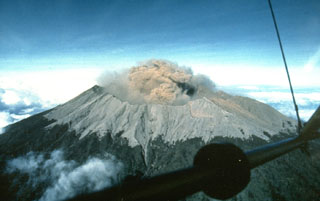Report on Raung (Indonesia) — 8 July-14 July 2015
Smithsonian Institution / US Geological Survey
Weekly Volcanic Activity Report, 8 July-14 July 2015
Managing Editor: Sally Sennert.
Please cite this report as:
Global Volcanism Program, 2015. Report on Raung (Indonesia) (Sennert, S, ed.). Weekly Volcanic Activity Report, 8 July-14 July 2015. Smithsonian Institution and US Geological Survey.
Raung
Indonesia
8.119°S, 114.056°E; summit elev. 3260 m
All times are local (unless otherwise noted)
PVMBG reported that during 1-8 July gray plumes rose 100-500 m above Raung’s crater rim, crater incandescence was observed, and rumbling and thumping sounds were noted. Seismicity was dominated by high-amplitude tremor; deformation data suggested magma migrating to the surface. The Alert Level remained at 3 (on a scale of 1-4), and the public was reminded not to approach the crater within a 3-km radius. BNPB reported that gray ash plumes continued to rise as high as 500 m above the crater through 11 July. Ash plumes drifted in various directions depending on the altitude: SE and S at lower altitudes and SE, S, W, and N at higher altitudes.
Based on PVMBG notices, wind data, and satellite images, the Darwin VAAC reported that during 8-12 July ash plumes rose to an altitude of 4.3-5.2 km (14,000-17,000 ft) a.s.l. and drifted as far as 1,040 km E, SE, and S. According to news articles, increased activity during 9-10 July caused flight cancelations and several airports to close, including those on Bali and Lombok, and in Banyuwangi and Jember in East Java. The article also noted that dozens of flight had been canceled during the previous week. Another article noted that the Bali airport, in addition to another airport in Java, again closed on 12 July, a day after it had reopened.
Geological Summary. Raung, one of Java's most active volcanoes, is a massive stratovolcano in easternmost Java that was constructed SW of the rim of Ijen caldera. The unvegetated summit is truncated by a dramatic steep-walled, 2-km-wide caldera that has been the site of frequent historical eruptions. A prehistoric collapse of Gunung Gadung on the W flank produced a large debris avalanche that traveled 79 km, reaching nearly to the Indian Ocean. Raung contains several centers constructed along a NE-SW line, with Gunung Suket and Gunung Gadung stratovolcanoes being located to the NE and W, respectively.
Sources: Badan Nacional Penanggulangan Bencana (BNPB), Darwin Volcanic Ash Advisory Centre (VAAC), Agence France-Presse (AFP), The Weather Channel

